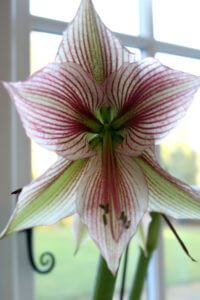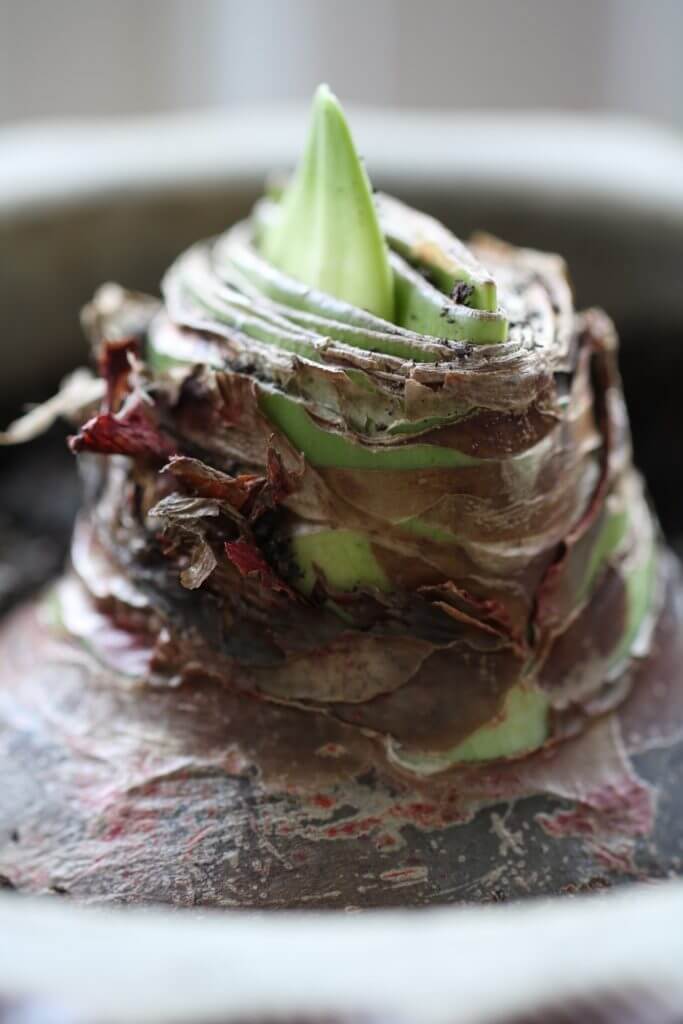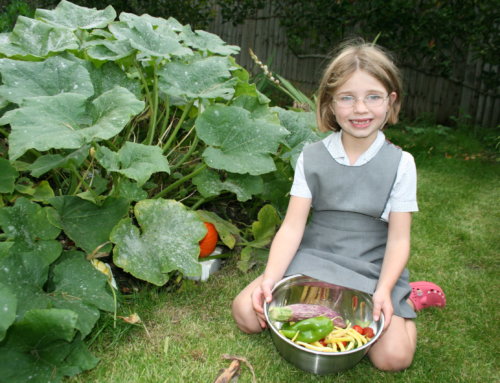Amaryllis* come from South America and I liken them to the ‘Brazilian Bombshell’, Carmen Miranda, famed for her vivacity, beauty and colourful hats. Just like Miranda, they are big, blowsy, colourful and you can’t take your eyes off them. These stunners will provide colour and glamour in your home for weeks and it’s not too late to plant a few. They will lift your spirits in these dark dreary winter months.
Amaryllis bulbs deliver incredible bang for buck. Each should produce at least two flower stalks, topped with four flowers. Depending on conditions they will flower for about a month, possibly longer in cooler rooms. Some suppliers sell larger bulbs, which will even put up a third or fourth stalk. By growing a few and staggering planting, you can enjoy their zing for weeks.
I can’t think of another houseplant with the ability to deliver so much joy at this time of year and at such little cost.
Choosing your Amaryllis
Amaryllis are easy to find in garden centres and online. Internet bulb suppliers are likely to have the greatest range though and just one look in a bulb supplier’s catalogue will reveal colours ranging from white, through apple-blossom shades, to shocking pink and the darkest burgundies.
An absolute favourite of mine is Papillo, with acid green flowers streaked in claret.
Good quality bulbs range in price from £8, up to £12 for the larger bulbs or unusual varieties. Even at full price, I think they are amazing value but many suppliers do have promotions so its worth shopping around. I have bought great quality bulbs from Sarah Raven, GeeTee Bulbs and J Parker.
When I buy bulbs in Autumn I don’t plant them all immediately as the last thing I want is for all to flower concurrently.
Having said that, I often find that bulbs planted at the same time, even of the same variety, rarely start shooting at the same time. Last year I had one in full flower before the green arrow-shaped shoot emerged from the second of the same variety.

Amaryllis Papillo
Grab yourself a sale bargain
January is a great time to buy Amaryllis and I often find post Christmas bargains from mid January onwards. Boxed decoratively with vase, compost and instructions, they make great gifts so many retailers stock up ahead of Christmas. In January, look in the bargain section of garden centres, DIY stores and supermarkets and you may be rewarded with a cut-price bulb or bulb kit. Also look at online sellers and bulb suppliers as those with unsold stock may be starting to discount.

Whilst it might be worrying to plant up bargain bulbs, when it comes to Amaryllis there really is little risk of failure. Remember that the grower has done the hard work of preparing the bulb. They have mimicked the plant’s natural habitat in the preceding season to ensure you have a bulb ready for bringing into growth at home.
Imagine it’s Carmen Miranda, waiting in the wings, and ready to samba onstage.
Unlike bulbs you buy in the autumn, those bought post Christmas are often already beginning to shoot. If you inspect your bulb and see the bright green, arrow shaped shoot, you can rejoice, as it really wants to flower. I have bought bulbs for as little as £3 in supermarket kits (with a ceramic pot and compost supplied as well). Online, post Christmas, I have bought named varieties at half price, for £4-5.
Easy to grow
I plant the bulbs in ordinary multi-purpose compost and don’t provide them with anything fancy as the energy the plant needs is stored in the bulb. I use a variety of containers, including terracotta pots, glass storm vases (great for seeing the root structures) and ceramic vases but I tend to choose fairly deep pots to encourage good root growth. They don’t need to have drainage holes but if you use ones withoutmake sure that you don’t overwater. Watering little and often is a good way to go.
When you plant the bulb, fill the container with compost to just below the desired level. Put the bulb on the surface and give it a little wiggle, as if you’re squeezing a lemon on a lemon squeezer. This will settle the roots into the compost and then you can fill the container up with more compost to about half way up the bulb. Water sparingly until the compost is just moist and place on a cool windowsill.
Be patient. It can sometimes take a while for the bulb to shoot. Once it does,you will find the rate of growth of the flower stalk astounding, sometimes an inch or two a day. Because of the rapid growth it’s worth turning your plant daily as the stalk will grow towards the light but will correct the following day after a half turn.The stalks are hollow and are strong but staking the pant with a stick or surrounding it in a cage of twigs will provide support once the heavy flower head opens. If it’s in a cool spot the flowers will last longer. Snip off the individual flowers as they fade, leaving those still going to shine.
Will your amaryllis flower again?
If you’re able to provide certain conditions then the answer to this question is yes but last year I admitted on this blog that I didn’t worry about getting them to re-flower. I treated them like a bouquet of flowers, to enjoy in their prime and then compost when they go over. Strictly speaking it is wasteful, but no more so than buying cut flowers.
However, this summer I decided to spare them the compost heap and have attempted to get them to reflower, so far with good results.
In early summer I moved all my potted Amaryllis outside, where I placed them on a table which I use for storing seedlings. I left the leaves on to allow the plants to photosynthesise and feed the bulbs.
I read that the best way to promote re-flowering is to put the bulbs in a cold place (even a fridge) and the cold snap we had in the UK in early October seems to have done the trick. Two bulbs have since sent up flower spikes and I have now moved all of the pots indoors now and cut off the leaves to await new flowers.
In conclusion, if you have space in your garden to babysit your amaryllis over the summer, then again indoors in autumn – then give this a go.







I still have an Amaryllis I was given by my mum in 2003. I have never repotted it, just water it regularly and it looks after itself. It grows a few big leaves every year and approximately every 2-3 years it flowers. It’s the longest I have managed to keep a houseplant alive!
What a lovely story. I’m sure it’s a beautiful reminder of your mum each time it puts on a show. I’m reminded that sometimes benign neglect is the way to go but I promise to try harder to look after this year’s bulbs!